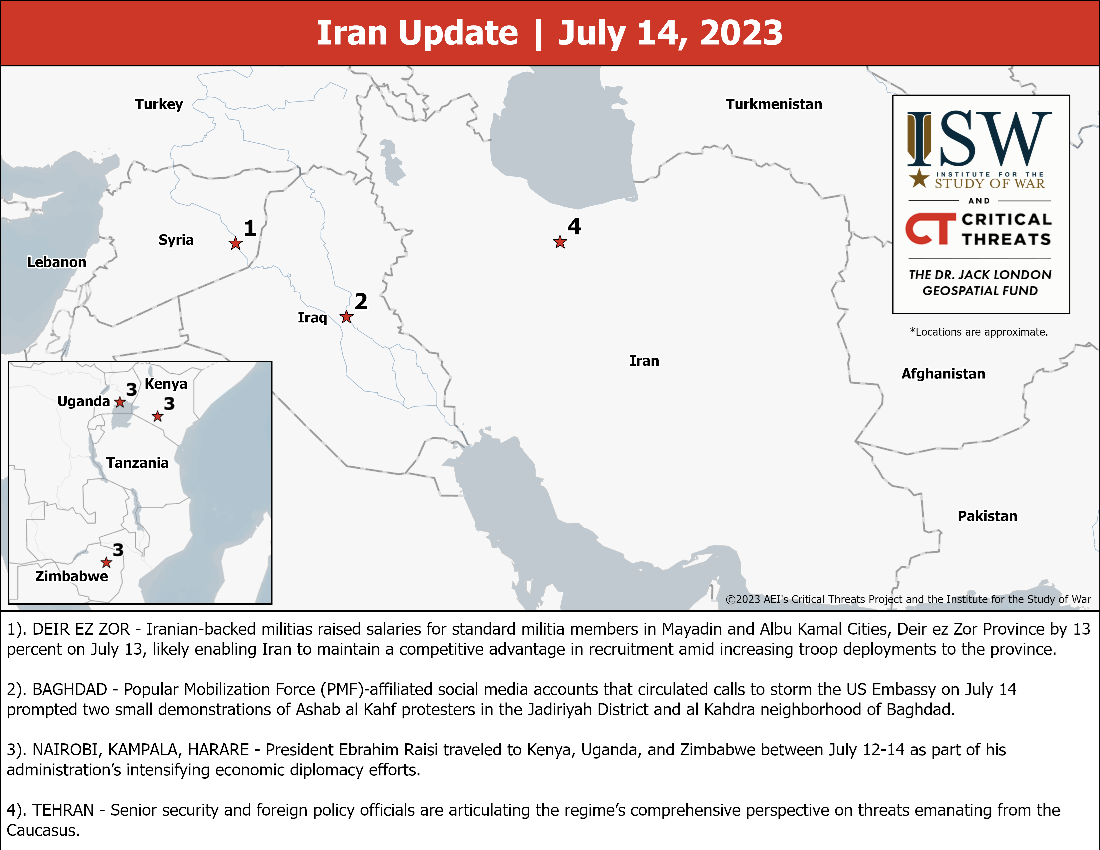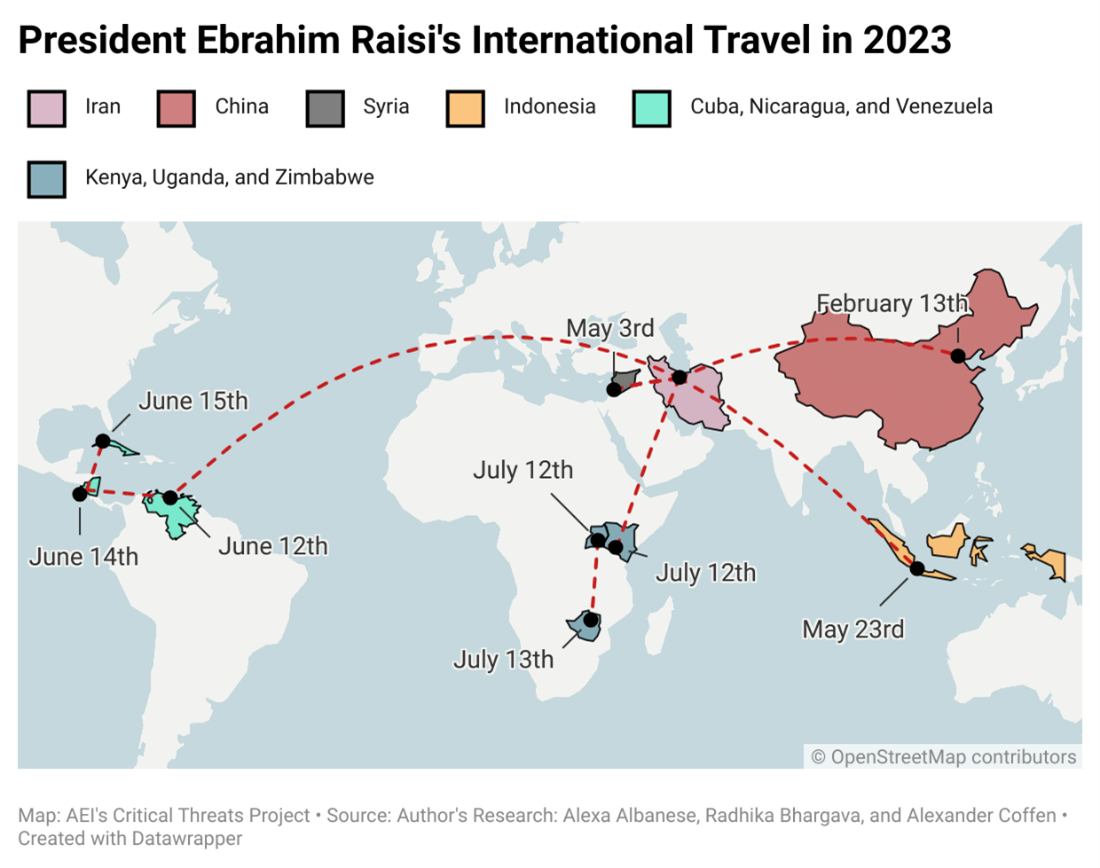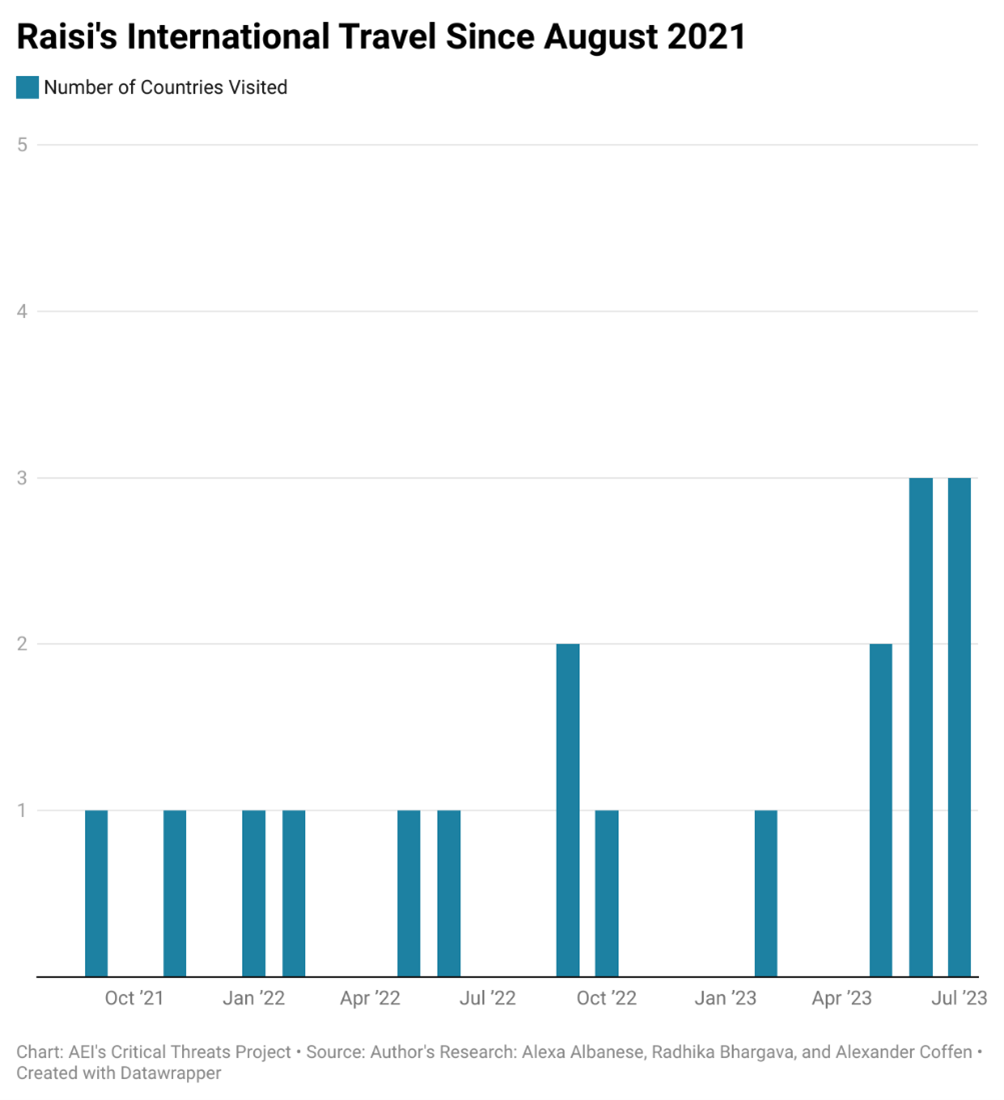 |
 |
Iran Update, July 14, 2023

Iran Update, July 14, 2023
Annika Ganzeveld, Amin Soltani, Johanna Moore, Ashka Jhaveri, Brandon Kanell, Alexa Albanese, Radhika Bhargava, and Alexander Coffen
The Iran Update aims to inform national security policy by providing timely, relevant, and independent open-source analysis of developments pertaining to Iran and its Axis of Resistance. This update covers political, military, and economic events and trends that affect the stability and decision-making of the Iranian regime. It also provides insights into Iranian and Iranian-sponsored activities abroad that undermine regional stability and threaten US forces and interests. The Critical Threats Project (CTP) at the American Enterprise Institute with support from the Institute for the Study of War (ISW) provides these updates Monday through Friday. To receive Iran Updates via email, please subscribe here.
The Institute for the Study of War (ISW) with support from the Critical Threats Project (CTP) at the American Enterprise Institute launched a new interactive map of Iran and the Middle East. The map depicts events in Iran that affect the stability of the Iranian regime, namely anti-regime protests and reported poisoning incidents. It also shows developments in Syria that jeopardize regional stability and pose threats to US forces and interests, including Iranian and Iranian-backed militia positions.
Key Takeaways
- Iranian-backed militias raised salaries for standard militia members in Mayadin and Albu Kamal Cities, Deir ez Zor Province by 13 percent on July 13, likely enabling Iran to maintain a competitive advantage in recruitment amid increasing troop deployments to the province.
- Popular Mobilization Force (PMF)-affiliated social media accounts that circulated calls to storm the US Embassy on July 14 prompted two small demonstrations of Ashab al Kahf protesters in the Jadiriyah District and al Kahdra neighborhood of Baghdad.
- President Ebrahim Raisi traveled to Kenya, Uganda, and Zimbabwe between July 12-14 as part of his administration’s intensifying economic diplomacy efforts.
- Senior security and foreign policy officials are articulating the regime’s comprehensive perspective on threats emanating from the Caucasus.
Iranian Activities in the Levant
This section covers Iranian efforts to consolidate and expand Tehran’s economic, military, and political influence throughout the Levant especially in Syria. This section examines some of the many campaigns that Iran is pursuing to achieve this strategic objective. CTP will update and refine our assessments of these campaigns over time and in future updates.
Iranian-backed militias raised salaries for standard militia members in Mayadin and Albu Kamal Cities, Deir ez Zor Province by 13 percent on July 13, likely enabling Iran to maintain a competitive advantage in recruitment amid increasing troop deployments to the province.[1] Iran and Iranian-backed militias increased local militia salaries by over 100,000 Syrian pounds (SYP), bringing the maximum militant salary to around 1,000,000 SYP.[2] Local news source Deir Ezzor 24 cited recent rumors of an attack by the International Coalition and SDF forces as the reason for the increase.[3] The Syrian National Defense Militia salaries for militants typically are around 300,00 SYP.[4]
The salaries for militants vary by role. The average Iranian-backed militant in Deir ez Zor received 600,000 SYP in February 2023.[5] The Iranian-backed Al-Bashir militia recruited volunteers to patrol the T2 station, Muayzila, and Al Salihiya, Albu Kamal City for 750,000 SYP.[6] Iranian-backed militias pay militants in less risky positions, such as guards, around 250,000 SYP.[7] This indicates that higher-risk jobs usually entail danger pay. Iran's decision to raise salaries in such an uncharacteristic manner demonstrates its concern of International Coalition and SDF attacks.
Iranian Activities in Iraq
This section covers Iranian efforts to consolidate and expand Tehran’s economic, military, and political influence throughout Iraq. This section examines some of the many campaigns that Iran is pursuing to achieve this strategic objective. CTP will update and refine our assessments of these campaigns over time and in future updates.
Popular Mobilization Force (PMF)-affiliated social media accounts that circulated calls to storm the US Embassy on July 14 prompted two small demonstrations of Ashab al Kahf protesters in the Jadiriyah District and al Kahdra neighborhood of Baghdad. PMF-affiliated social media accounts first circulated calls on July 11 to storm the US Embassy in protest of US sanctions that supporters claimed were responsible for energy cuts from Iran.[8] Key Iranian-backed Iraqi proxies did not support the calls to storm the US Embassy in Baghdad, as CTP previously reported.[9] Local social media footage showed approximately 100-200 protesters total carrying Ashab al Kahf flags and portraits of former Islamic Revolutionary Guard Corps Quds Force Commander Qassem Soleimani and former PMF Chairman Abu Mahdi al Muhandis. That Ashab al Kahf motivated only two small demonstrations suggests that the group has a small base of support. Ashab al Kahf protesters briefly came into contact with police in riot gear on the 14 of July suspension bridge connecting the Green Zone to Jadiriyah District but did not escalate into any violence.[10] CTP did not record any indications that other Iraqi proxies participated in the protests.
The head of Asaib Ahl al Haq’s political wing, Hassan Salem, and the head of Kataib Hezbollah’s political wing, Hossein Monis, spoke at the demonstrations and discussed continued political resistance against the United States.[11] Neither called for supporters to join the protests. Both of the militias’ political wings are members of the Shia Coordination Framework and the majority coalition in the Iraqi Parliament. Salem and Monis’ statements highlight KH and AAH’s interest in protecting political stability for the Coordination Framework. Their stances are consistent with a statement from Badr Organization Secretary General Hadi al Ameri on July 13 in which he called for a unified political stance against the US Treasury to fight for Iraq’s independence from the United States.[12] This indicates the Framework is not giving priority to expelling the United States from Iraq.
Iranian Domestic and Political Affairs
This section covers factors and trends affecting regime decision-making and stability. CTP will cover domestic politics, significant protest activity, and related issues here.
President Ebrahim Raisi traveled to Kenya, Uganda, and Zimbabwe between July 12-14 as part of his administration’s intensifying economic diplomacy efforts. Raisi's trip marks the first Iranian presidential visit to Africa in over a decade.[13] This trip follows Raisi’s visits to Indonesia in late May and Cuba, Nicaragua, and Venezuela in early June, which were similarly focused on economic cooperation.[14] No Iranian president had traveled to Indonesia since 2006, to Nicaragua since 2007, and to Cuba and Venezuela since 2016.[15] Raisi’s visits to these countries within the span of two months demonstrate that his administration is doubling down on its “neighborhood policy,” which is an economic policy centered on building relations with regional and extra-regional states to undermine Western sanctions.[16]
The Raisi administration is pursuing extraterritorial cultivation in Africa, which will help Iran conserve its water resources. Conserving water could reduce protests caused by water shortages in Iran. Extraterritorial cultivation refers to Iran using arable land in other countries to grow crops and then exporting the crops to Iran.[17] President Ebrahim Raisi attended the launch of “Iran's extraterritorial cultivation in Uganda” on July 12.[18] 80 percent of Uganda’s land is arable, presenting an opportunity for Iran to export its agricultural production to this country.[19] Transferring agricultural production to Uganda would help Iran conserve water, especially since Iran currently uses about 90 percent of its water for agriculture.[20] Water shortages have previously precipitated large-scale protests in Iran. Hundreds of Esfahan Province residents previously protested water shortages in November 2021, for example.[21] Iran has gained extraterritorial cultivation land in other countries, such as Venezuela.[22]
Iran seeks to undermine and mitigate the impact of Western sanctions through greater economic cooperation with Kenya, Uganda, and Zimbabwe. Iranian officials and media have emphasized Africa’s mineral richness in recent days. State-controlled IRNA reported on July 10 that African countries can export gold and diamonds to Iran.[23] Iranian Ambassador to Uganda Majid Saffar separately stated on July 12 that Uganda’s mineral reserves and natural resources are “definitely needed” by Iran.[24] The Iranian regime uses gold to evade Western sanctions by allowing exporters to repay export-related dues to the government using gold instead of hard currency.[25] Iran's Trade Promotion Organization additionally announced in May that Iran imported a “record amount” of gold between March and May “to get around US sanctions.”[26]
Iran also seeks to increase oil sales to African countries. President Ebrahim Raisi stated on July 14 that Iran agreed to import basic goods from unspecified African countries in return for petrochemical products and materials.[27] High-ranking Iranian and Zimbabwean officials signed 12 cooperation agreements, including an oil and energy agreement, on July 13.[28] It is unclear whether Iran is pursuing similar energy agreements with Kenya and Uganda. Kenya previously cancelled an agreement to import 4 million tons of Iranian crude oil per year after Western countries threatened it with sanctions in 2012.[29]
Greater bilateral trade with African countries will increase Iran's capital inflows but will not solve the problems that underlie Iran’s economic instability. Fundamental economic reforms—such as reducing the dominance of para-statal organizations in Iran’s economy, combatting corruption and nepotism, and diversifying exports—would be necessary to meaningfully improve Iran’s economy.[30]
Senior security and foreign policy officials are articulating the regime’s comprehensive perspective on threats emanating from the Caucasus. Supreme Leader Foreign Policy Advisor Ali Akbar Velayati warned Russia on July 13 about possible NATO interference and aggression in the Caucasus.[31] Velayati argued that the change in Turkey’s policies vis-à-vis NATO, such as agreeing to approve Sweden’s NATO ascension, and Turkey’s links to Azerbaijan, raises the risk of conflict in the Caucus region. He highlighted that such conflict would lead to long-term tensions in the region that Iran’s adversaries—specifically the United States and Israel—will exploit to “undermine the security of the entire region.” Velayati is a senior adviser to Supreme Leader Ali Khamenei, which means his statements reflect the views of the supreme leader and the threats he perceives to Iranian interests. That Velayati’s letter was written in English also suggests that it was intended for a foreign and not Iranian audience.
Velayati’s comments are consistent with recent statements by other representatives from the Supreme Leader’s office about the Caucasus, as well as the regime’s overall perspective on threats in the region.[32] Regime officials have repeatedly expressed similar concerns about the United States and Israel exploiting conflict and the presence of anti-regime separatist groups in northern Iraq to undermine Iran’s security interests.[33] Velayati stressed this warning to Russia by stating that “our Russian friends need to be careful” not to neglect the Caucasus as “ill-intending parties…would attack the interests of Russia and the Islamic Republic of Iran.” He argued that Russia has abandoned the Caucasus after its invasion of Ukraine in February 2022 and needs to be cognizant of the potential for conflict and competition in the region.
Velayati presented the threat of Turkish expansionism in the region as a mutual Russo-Iranian security interest. Velayati warned Russia that Turkey’s pan-Turkic aspirations to connect areas where Turkic populations reside between Istanbul and Xinijang could create an area in which NATO influence spreads and geographically separates Iran and Russia. He emphatically stated that this “this should be a red line of Iran and Russia.” Russia and Iran are home to significant Turkic populations. Both have been concerned since the 2020 Nagorno-Karabakh War that pan-Turkic rhetoric will prompt Turkic secessionist movements in Iran and Russia.[34]
Velayati also responded to the joint Russia-Gulf Cooperation Council statement on July 10 about Iran’s claim to three disputed islands in the Persian Gulf with the warning that Iran’s “Russian friends” not to be naïve. The joint statement expressed support for the Emirati claim to the three Iranian-controlled Islands in the Persian Gulf.[35] Iranian officials and media responded negatively to the statement between July 12 and 13, as CTP previously reported.[36] Chinese and Russian support for the Emirati claim to the three islands is part of their strategy to simultaneously balance their relationships with Iran and the Gulf Arab states.[37]
IRGC Commander Major General Hossein Salami stated that the Islamic Revolution is experiencing its "most sensitive time” during a meeting with national and provincial military commanders in Ahvaz, Khuzestan Province on July 13.[38] Salami added that Iran’s enemies are targeting Iranian youth and that the Islamic Republic “must save our children from the enemy’s fire.” These statements underscore that the regime remains concerned over the potential for instability among the Iranian population, particularly youth. University students largely spearheaded the Mahsa Amini movement between September 2022 and January 2023.[39] These statements also follow Supreme Leader Ali Khamenei’s July 12 speech in which he stated that Iranian youth should be the “focus” of “innovative propaganda.”[40]
Roads and Urban Development Ministry Infrastructure Affairs Representative Hossein Mir Sharifi announced on July 13 that Iran and Afghanistan are seeking to attract Chinese investment and participation in the construction of a Chinese-Iranian-Afghan railway corridor.[41] Iran and Afghanistan also inaugurated that Khaf, Khorasan Razavi Province, Iran-Herat City, Herat Province, Afghanistan railway on July 13.[42] Sharifi stated that the Khaf-Herat railway “completes” the 2,000-kilometer east-west rail corridor that connects China, Afghanistan, and Iran to Europe. Iran has frequently relied on foreign countries to finance its infrastructure projects. Russia agreed to partially finance Iranian construction of the Rasht-Astara railway on May 17, for example.[43]
[1] https://deirezzor24 dot net/%d9%85%d9%8a%d9%84%d9%8a%d8%b4%d9%8a%d8%a7-%d8%a7%d9%84%d8%ad%d8%b1%d8%b3-%d8%a7%d9%84%d8%ab%d9%88%d8%b1%d9%8a-%d8%a8%d8%af%d9%8a%d8%b1%d8%a7%d9%84%d8%b2%d9%88%d8%b1-%d8%aa%d8%b2%d9%8a%d8%af-%d9%85/
[2] https://deirezzor24 dot net/%d9%85%d9%8a%d9%84%d9%8a%d8%b4%d9%8a%d8%a7-%d8%a7%d9%84%d8%ad%d8%b1%d8%b3-%d8%a7%d9%84%d8%ab%d9%88%d8%b1%d9%8a-%d8%a8%d8%af%d9%8a%d8%b1%d8%a7%d9%84%d8%b2%d9%88%d8%b1-%d8%aa%d8%b2%d9%8a%d8%af-%d9%85/
https://deirezzor24 dot net/%d9%85%d9%8a%d9%84%d9%8a%d8%b4%d9%8a%d8%a7-%d8%a7%d9%84%d8%ad%d8%b1%d8%b3-%d8%a7%d9%84%d8%ab%d9%88%d8%b1%d9%8a-%d8%a8%d8%af%d9%8a%d8%b1%d8%a7%d9%84%d8%b2%d9%88%d8%b1-%d8%aa%d8%b2%d9%8a%d8%af-%d9%85/
[3] https://deirezzor24 dot net/%d9%85%d9%8a%d9%84%d9%8a%d8%b4%d9%8a%d8%a7-%d8%a7%d9%84%d8%ad%d8%b1%d8%b3-%d8%a7%d9%84%d8%ab%d9%88%d8%b1%d9%8a-%d8%a8%d8%af%d9%8a%d8%b1%d8%a7%d9%84%d8%b2%d9%88%d8%b1-%d8%aa%d8%b2%d9%8a%d8%af-%d9%85/
https://eyeofeuphrates.com/ar/news/2023/07/08/9070
[4] https://eyeofeuphrates.com/ar/news/2023/07/08/9070
[5] https://deirezzor24 dot net/%d9%85%d9%8a%d9%84%d9%8a%d8%b4%d9%8a%d8%a7-%d8%a7%d9%84%d8%ad%d8%b1%d8%b3-%d8%a7%d9%84%d8%ab%d9%88%d8%b1%d9%8a-%d8%a8%d8%af%d9%8a%d8%b1%d8%a7%d9%84%d8%b2%d9%88%d8%b1-%d8%aa%d8%b2%d9%8a%d8%af-%d9%85/
[6] https://deirezzor24.net/en/al-bashir-recruits-new-volunteers-for-the-iranian-revolutionary-guard-militia/
[7] https://eyeofeuphrates.com/ar/news/2023/06/08/8775
[8] https://www.criticalthreats.org/analysis/iran-update-july-11-2023
[9] https://www.criticalthreats.org/analysis/iran-update-july-13-2023?mkt_tok=NDc1LVBCUS05NzEAAAGM8LA3CS79Y3Rz7Op31pTW_LGV9dZk4UPf7f15trHT1gvq4FaGyrS_N4USln7Oj3KqziAk8vPnlS8tarkpOSgRn4tM3O9EVj0QgWzMBbXeVQTifk8v
[10] https://shafaq dot com/ar/%D8%B3%DB%8C%D8%A7%D8%B3%D8%A9/%D8%A7%D9%86%D8%B5%D8%A7%D8%B1-%D9%81%D8%B5%D8%A7-%D9%84-%D8%B4%D9%8A%D8%B9%D9%8A%D8%A9-%D8%B9%D8%B1%D8%A7%D9%82%D9%8A%D8%A9-%D9%8A%D8%AA%D8%B8%D8%A7%D9%87%D8%B1%D9%88%D9%86-%D8%A7%D8%AD%D8%AA%D8%AC%D8%A7%D8%AC%D8%A7-%D8%B9%D9%84%D9%89-%D8%AA%D8%AF%D8%AE%D9%84%D8%A7%D8%AA-%D9%85%D8%B1%D9%8A%D9%83%D8%A7-%D9%88%D8%AA%D9%87%D8%AF%D9%8A%D8%AF%D9%87%D8%A7-%D8%A8%D8%AA%D8%B5%D9%81%D9%8A%D8%A9-%D9%82%D8%A7%D8%AF%D8%AA%D9%87%D9%85%20;
[11] https://t.me/sabreenS1/79868
[12] https://shafaq dot com/ar/%D8%B3%DB%8C%D8%A7%D8%B3%D8%A9/%D8%A7%D9%84%D8%B9%D8%A7%D9%85%D8%B1%D9%8A-%D9%8A%D8%B7%D8%A7%D9%84%D8%A8-%D8%A8%D9%85%D9%88%D9%82%D9%81-%D9%85%D9%88%D8%AD%D8%AF-%D9%84%D9%80-%D8%A7%D8%B3%D8%AA%D9%82%D9%84%D8%A7%D9%84-%D8%A7%D9%84%D8%B9%D8%B1%D8%A7%D9%82-%D9%85%D9%88%D8%B8%D9%81-%D8%A8%D8%A7%D9%84%D8%AE%D8%B2%D8%A7%D9%86%D8%A9-%D8%A7%D9%84-%D9%85%D8%B1%D9%8A%D9%83%D9%8A%D8%A9-%D9%8A%D8%AA%D8%AD%D9%83%D9%85-%D9%81%D9%8A%D9%86%D8%A7
[13] https://president dot ir/fa/145327
[14] https://www.criticalthreats.org/analysis/iran-update-may-24-2023 ;
https://www.criticalthreats.org/analysis/iran-update-june-16-2023-
[15] https://www.criticalthreats.org/analysis/iran-update-may-24-2023 ;
https://www.france24 dot com/en/live-news/20230613-iran-and-venezuela-have-common-enemies-raisi-says-in-caracas
[16] https://www.criticalthreats.org/analysis/iran-update-june-21-2023
[17] https://en.irna dot ir/news/84255308/Iran-considering-opportunities-for-Asian-extra-territorial-cultivation
[18] https://president dot ir/fa/145406
[19] https://www.trade.gov/country-commercial-guides/uganda-agricultural-sector
[20] https://iranprimer.usip.org/blog/2021/dec/05/explainer-irans-water-bankruptcy
[21] https://www.reuters.com/markets/commodities/protesters-police-clash-central-iran-after-rally-over-water-shortages-2021-11-26/
[22] https://www.mei.edu/publications/iran-venezuela-relations-presidents-postures-and-pressures
[23] https://www.irna dot ir/news/85165410
[24] https://www.irna dot ir/news/85166313
[25] https://en.mehrnews dot com/news/201267/Iran-s-gold-for-export-receipts-top-1mt-in-March-May
[26] https://en.mehrnews dot com/news/201267/Iran-s-gold-for-export-receipts-top-1mt-in-March-May
[27] https://president dot ir/fa/145476
[28] https://president.ir/fa/145451
[29] https://www.reuters.com/article/uk-kenya-iran/wary-of-sanctions-kenya-cancels-iran-oil-deal-idUKBRE8630CX20120704
[30] https://www.criticalthreats.org/analysis/iran-update-july-10-2023
[31] https://www.tehrantimes dot com/news/486826/Velayati-urges-vigilance-in-face-of-NATO-plot
[32] https://www.tasnimnews dot com/fa/news/1402/04/21/2924658
[33] https://www.tasnimnews dot com/fa/news/1402/04/20/2924321
[34] https://www.mei.edu/publications/iran-turkey-and-future-south-caucasus ; https://www.mei.edu/publications/iran-and-turkey-power-dynamics-south-caucasus
[35] https://www.cnbc.com/2023/07/12/iran-at-odds-with-allied-russia-after-moscow-backs-uae-in-island-dispute.html
[36] https://www.criticalthreats.org/analysis/iran-update-july-12-2023
[37] https://www.atlanticcouncil.org/blogs/menasource/china-is-getting-comfortable-with-the-gulf-cooperation-council-the-west-must-pragmatically-adapt-to-its-growing-regional-influence/ ; https://www.jstor.org/stable/pdf/resrep21138.13.pdf
[38] https://www.farsnews dot ir/khuzestan/news/14020422000586 ;
https://iranwire dot com/en/news/118492-irgc-chief-the-islamic-republic-goes-through-its-most-sensitive-time-ever/#google_vignette
[39] https://www.criticalthreats.org/analysis/iran-update-may-23-2023
[40] https://www.leader dot ir/fa/content/26599
[41] https://www.farsnews dot ir/news/14020422000505
[42] https://thediplomat.com/2023/06/afghanistan-iran-complete-first-trial-run-of-khaf-herat-railway/
[43] https://www.criticalthreats.org/analysis/iran-update-july-7-2023?mkt_tok=NDc1LVBCUS05NzEAAAGM0jNn1bV7mJo94O38dir3yr_l9y7LREGrT3RuwNsHJFx_-GB1lyx61KqzzK76TrhGDthVuP7X-kFQc9M3a0oNJZ-Qys44fRDCrIdstRUwR-zkHqhv


